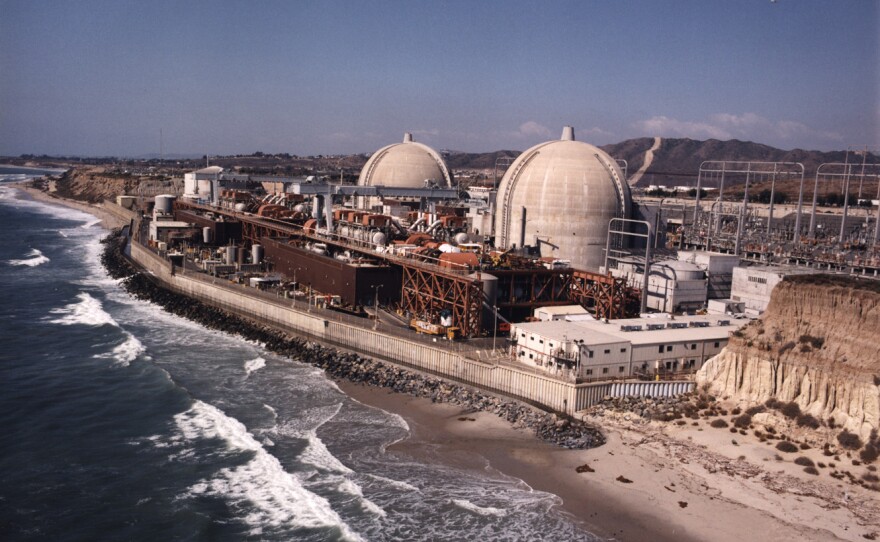The Associated Press recently analyzed the earthquake risk at U.S. nuclear power plants. The AP analysis of government data shows quakes pose a greater risk for a severe accident at nuclear plants than previously thought. KPBS Environment Reporter Ed Joyce interviewed Gil Alexander with Southern California Edison, which operates the San Onofre Nuclear Generating Station, about safety at the plant.
Ed Joyce: In terms of the AP analysis, which mentions 27 U.S. reactors with the greatest seismic risk or risk of core damage: Is the San Onofre Nuclear Generating Station or SONGS on that list?
Gil Alexander: No. The two California plants are probably among the most prepared for this type of threat and for obvious reasons. Because California in every way, including public safety, has to be ready for an earthquake.
Joyce: San Diego State University Professor Emeritus of Geology Pat Abbott has said a massive earthquake, like the one that hit Japan, is not possible in San Diego County. He said a magnitude-7.2 is possible for the Elsinore and Rose Canyon Faults in this area.
What kind of events, earthquake and say, a tsunami, is SONGS designed to withstand?
Alexander: In general when you design and build a U.S. nuclear plant you have to do a thorough scientific assessment of that threat and then the principle used in design and construction is to overbuild. So when we built the two reactor units at San Onofre in the 1980s, we did an assessment of this type of threat that you're talking about and then we went beyond that in the ability of the key safety structures at the plant to withstand an earthquake. Specifically, we're north of a 7-point magnitude earthquake, five or so miles from the plant. We don't sit on a fault but we're prepared for that size of a quake nearby.
Joyce: People were concerned after the disaster in Japan - the earthquake and the tsunami that followed and the effect at Fukushima - what about a seawall at San Onofre?
Alexander: Similarly, we did the best science that was available when we built the plant and strengthened the property. The finding was that we probably face a maximum about a 25-foot wall. So again we overbuilt. In our case we have a 30-foot wall between the ocean and the plant. In some cases key safety equipment, like the diesel backup generators and their fuel tanks, are even higher than that.
Joyce: The Nuclear Regulatory Commission tracks the safety of facilities. In 2010 the NRC was concerned about some safety issues related to the operation of the plant. What's changed at San Onofre since the NRC issued its 2010 report card for SONGS?
Alexander: We expect to see the NRC go public (perhaps Tuesday September 6) with its very latest assessment of how we're doing. I think the short version of it is that we have faced some problems and some challenges over the last several years that have been unacceptable to us. We essentially new management at the top layer at the plant over the last couple of years. We've seen the results of the steps that have been taken and we hope and expect that this latest assessment coming just after the Labor Day holiday will reflect those improvements.
Joyce: And can you update us on any recent changes, equipment upgrades or other work going on at the plant right now?
Alexander: It's a continuous process actually. I think one of the impressions that the Associated Press story left that is probably inaccurate, is that assessing earthquake threats and tsunami threats is something that happens infrequently and the plant operators have to be forced into it by the government. That's just simply not the case. In fact we did our latest full assessment and submitted it to the state of California and the regulator in February of this year and then in April proposed the largest new seismic and tsunami assessment for San Onofre in our operating history - a $64 million plan. We recently replaced and upgraded the four largest components at the plant, they're called steam generators.
Joyce: And finally Gil, in advance of the upcoming ten-year anniversary of the 9/11 attacks, how secure is the San Onofre Nuclear Generating Station and other U.S. Nuclear power plants?
Alexander: From a communications standpoint that's one of those questions you wish you could answer, but we're bound by security requirements that prohibit talking about exactly how we keep the plant safe. I often wish that every neighbor of the plant, everyone that lives within the plant's operating region, could come by and take a tour with us because you would instantly recognize how safe the plant is. I think in summary, it is accurate to say facilities like the San Onofre Nuclear Generating Station hardened secure sites in the United States.
Joyce: Gil Alexander, thank you.
Alexander: My pleasure.







